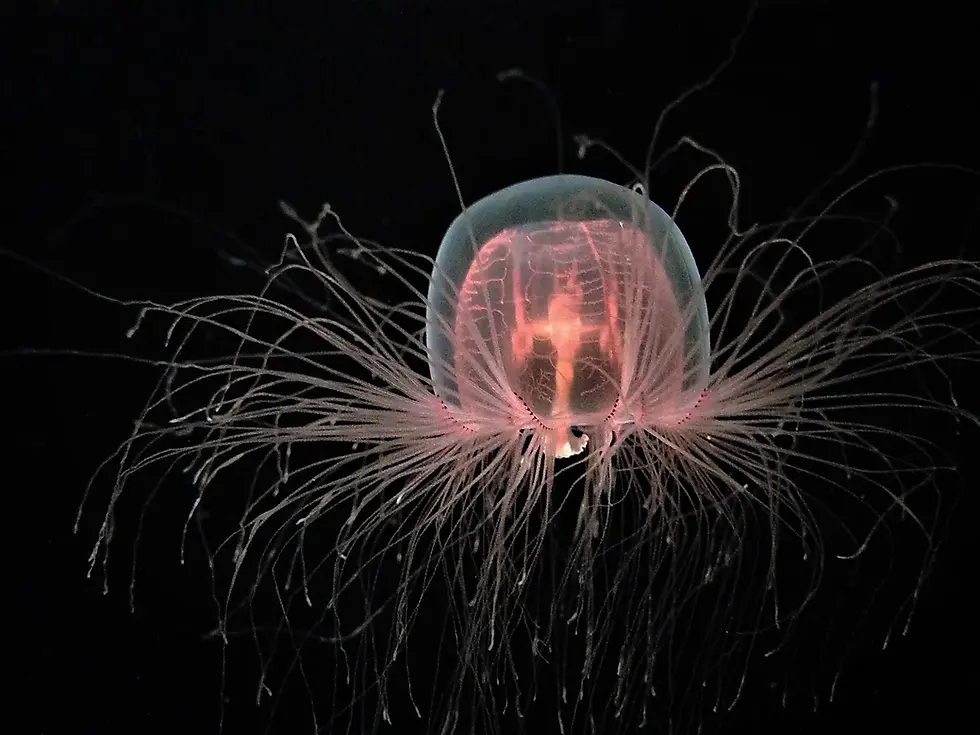Jellyfish: The Secret to Immortality
- Sarah Guan
- Nov 10, 2023
- 2 min read
Columbia, MO

Immortality—the ability to live forever. It’s something people have long coveted the answers to but have never fully understood nor uncovered. And while humans are still mortal, another animal seems to have discovered the secret to immortality. This animal, which has long been dubbed “biologically” immortal, is named “the immortal jellyfish.”
Its scientific name is Turritopsis dohrnii, and to the average person, it means nothing. However, call it the immortal jellyfish, and now you’ve revealed its most defining feature: its immortality. But that raises the question of how they are immortal. And if we can’t find the secret to immortality, how is it possible that these brainless blobs that mindlessly float in the ocean already have? What are they doing that we have yet to discover? Well, these jellyfish can reverse their life cycles through a process known as “transdifferentiation” where already “differentiated” cells (ones that have a specialized purpose in an organism) can transform into a different type of cell.

Jellyfish have a specific life cycle: egg to larva to polyp to a medusa, which is an adult jellyfish. Though the immortal jellyfish lives through the same life cycle, this is also where the immortal jellyfish differs from other types of sea jellies. When an adult immortal jellyfish is injured or stressed, they can absorb their tentacles and settle on the floor. On the seafloor, it is unable to move, yet it can heal itself. For around a day and a half, the injured medusa regenerates itself into its previous stage (a polyp) by switching the cells specific for an adult jelly to the cells for polyps. Then, the sea jelly can re-mature into a medusa. And viola—with this method, the immortal jellyfish can almost live forever, thus why it’s known as being “biologically immortal.”
So, if the immortal jellyfish can use transdifferentiation, what other animals can?

Well, it seems to be a relatively rare process in the animal kingdom. However, one other animal that can use transdifferentiation is a newt. When newts lose or injure part of their eyeball lens or their limbs, they can use transdifferentiation to regenerate said lens and limbs. This is called "Wolffian regeneration" in newts.
Now, this raises the question of whether other animals who use transdifferentiation are immortal. Well, the immortal jellyfish is the only species to be declared “biologically immortal.” But who knows? Perhaps scientists will eventually discover the formula for immortality for humans, leading us to live a similar life span to that of the immortal jellyfish.
Sources:
Berthold, Emma. “The Animals That Can Live Forever.” Curious, 24 May 2021, www.science.org.au/curious/earth-environment/animals-can-live-forever.
“Box Jellyfish.” Encyclopædia Britannica, Encyclopædia Britannica, inc., 11 July 2023, www.britannica.com/animal/box-jellyfish.
“Immortal Jellyfish: The Secret to Cheating Death.” Natural History Museum, www.nhm.ac.uk/discover/immortal-jellyfish-secret-to-cheating-death.html. Accessed 3 Sept. 2023.
“Transdifferentiation.” Encyclopædia Britannica, Encyclopædia Britannica, inc., www.britannica.com/science/transdifferentiation. Accessed 7 Sept. 2023.
REGISTER FOR OUR UPCOMING EVENTS
VOLUNTEER AT OUR UPCOMING EVENTS
















Comments